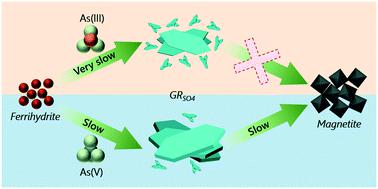当前位置:
X-MOL 学术
›
Environ. Sci.: Nano
›
论文详情
Our official English website, www.x-mol.net, welcomes your
feedback! (Note: you will need to create a separate account there.)
Arsenic species delay structural ordering during green rust sulfate crystallization from ferrihydrite
Environmental Science: Nano ( IF 5.8 ) Pub Date : 2021-08-23 , DOI: 10.1039/d1en00384d Jeffrey Paulo H. Perez 1, 2 , Dominique J. Tobler 3, 4 , Helen M. Freeman 5 , Andy P. Brown 5 , Nicole S. Hondow 5 , Case M. van Genuchten 6 , Liane G. Benning 1, 2
Environmental Science: Nano ( IF 5.8 ) Pub Date : 2021-08-23 , DOI: 10.1039/d1en00384d Jeffrey Paulo H. Perez 1, 2 , Dominique J. Tobler 3, 4 , Helen M. Freeman 5 , Andy P. Brown 5 , Nicole S. Hondow 5 , Case M. van Genuchten 6 , Liane G. Benning 1, 2
Affiliation

|
Green rust (GR) is an Fe(II)–Fe(III)-bearing phase that forms in oxygen-poor and Fe2+-rich subsurface environments where it influences trace element cycling and contaminant dynamics. GR phases have been shown to have high arsenic (As) uptake under anoxic and circum-neutral pH conditions. While geochemical controls on As uptake by GR have been identified, we still lack a fundamental understanding about GR formation in As-contaminated soils and groundwater, as well as the stability of As-bearing GR solids. In this study, we quantified the influence of As(III) and As(V) ([As]initial = 100 μM) on GR sulfate (GRSO4) crystallization during the Fe2+-induced transformation of ferrihydrite (FHY) at pH 8 (As/Fesolid = 0.008, Fe2+(aq)/Fe(III)FHY = 3). We also documented the behavior of mineral-bound As during GRSO4 crystallization and its transformation to magnetite. Our results showed that, compared to the As-free system, adsorbed As species delayed FHY transformation to GRSO4. Moreover, As(III) had a stronger inhibitory effect (at least eight-fold) than As(V) on GRSO4 crystallization, and reduced structural coherence and ordering in As(III)-bearing GRSO4 crystals. During FHY dissolution, we observed an initial release of ∼14 μM As(III) into the aqueous phase, but this was quickly adsorbed by newly-formed GRSO4 crystals. Mineral-bound As(III) resulted in at least four-fold increase in GRSO4 phase stability compared to As(V), and fully prevented its transformation to magnetite even after 720 h. Our results provide new information on the pathways of interaction of common Fe phases exposed to reducing, Fe2+-bearing and As-contaminated fluids and how these affect the structure, morphology and stability of As-bearing GR phases.
中文翻译:

砷物种在水铁矿绿锈硫酸盐结晶过程中延迟结构排序
绿锈 (GR) 是一种含 Fe( II )–Fe( III ) 的相,它在缺氧和富含Fe 2+ 的地下环境中形成,在这些环境中它会影响微量元素循环和污染物动力学。GR 相已被证明在缺氧和中性 pH 条件下具有高砷 (As) 吸收。虽然已经确定了 GR 对 As 吸收的地球化学控制,但我们仍然缺乏对砷污染土壤和地下水中 GR 的形成以及含砷 GR 固体的稳定性的基本了解。在这项研究中,我们量化了 As( III ) 和 As( V )([As]初始= 100 μM)对Fe 过程中GR 硫酸盐 (GR SO 4 ) 结晶的影响在 pH 8 时2+诱导水铁矿 (FHY) 转变(As/Fe固体= 0.008,Fe 2+ (aq) /Fe( III ) FHY = 3)。我们还记录了矿物结合 As 在 GR SO 4结晶过程中的行为及其向磁铁矿的转变。我们的结果表明,与无 As 系统相比,吸附的 As 物种延迟了 FHY 向 GR SO 4 的转化。此外,As( III )对GR SO 4结晶具有比As( V )更强的抑制作用(至少8倍),并降低了含As( III )的GR中的结构连贯性和有序性SO 4晶体。在 FHY 溶解过程中,我们观察到约 14 μM As( III )初始释放到水相中,但这很快被新形成的 GR SO 4晶体吸附。与 As( V )相比,与矿物结合的 As( III ) 使 GR SO 4相稳定性至少增加了四倍,并且即使在 720 小时后也完全阻止了其向磁铁矿的转变。我们的结果提供了关于暴露于还原性、含 Fe 2+和 As 污染流体的常见 Fe 相相互作用途径的新信息,以及这些如何影响含 As GR 相的结构、形态和稳定性。
更新日期:2021-08-31
中文翻译:

砷物种在水铁矿绿锈硫酸盐结晶过程中延迟结构排序
绿锈 (GR) 是一种含 Fe( II )–Fe( III ) 的相,它在缺氧和富含Fe 2+ 的地下环境中形成,在这些环境中它会影响微量元素循环和污染物动力学。GR 相已被证明在缺氧和中性 pH 条件下具有高砷 (As) 吸收。虽然已经确定了 GR 对 As 吸收的地球化学控制,但我们仍然缺乏对砷污染土壤和地下水中 GR 的形成以及含砷 GR 固体的稳定性的基本了解。在这项研究中,我们量化了 As( III ) 和 As( V )([As]初始= 100 μM)对Fe 过程中GR 硫酸盐 (GR SO 4 ) 结晶的影响在 pH 8 时2+诱导水铁矿 (FHY) 转变(As/Fe固体= 0.008,Fe 2+ (aq) /Fe( III ) FHY = 3)。我们还记录了矿物结合 As 在 GR SO 4结晶过程中的行为及其向磁铁矿的转变。我们的结果表明,与无 As 系统相比,吸附的 As 物种延迟了 FHY 向 GR SO 4 的转化。此外,As( III )对GR SO 4结晶具有比As( V )更强的抑制作用(至少8倍),并降低了含As( III )的GR中的结构连贯性和有序性SO 4晶体。在 FHY 溶解过程中,我们观察到约 14 μM As( III )初始释放到水相中,但这很快被新形成的 GR SO 4晶体吸附。与 As( V )相比,与矿物结合的 As( III ) 使 GR SO 4相稳定性至少增加了四倍,并且即使在 720 小时后也完全阻止了其向磁铁矿的转变。我们的结果提供了关于暴露于还原性、含 Fe 2+和 As 污染流体的常见 Fe 相相互作用途径的新信息,以及这些如何影响含 As GR 相的结构、形态和稳定性。







































 京公网安备 11010802027423号
京公网安备 11010802027423号